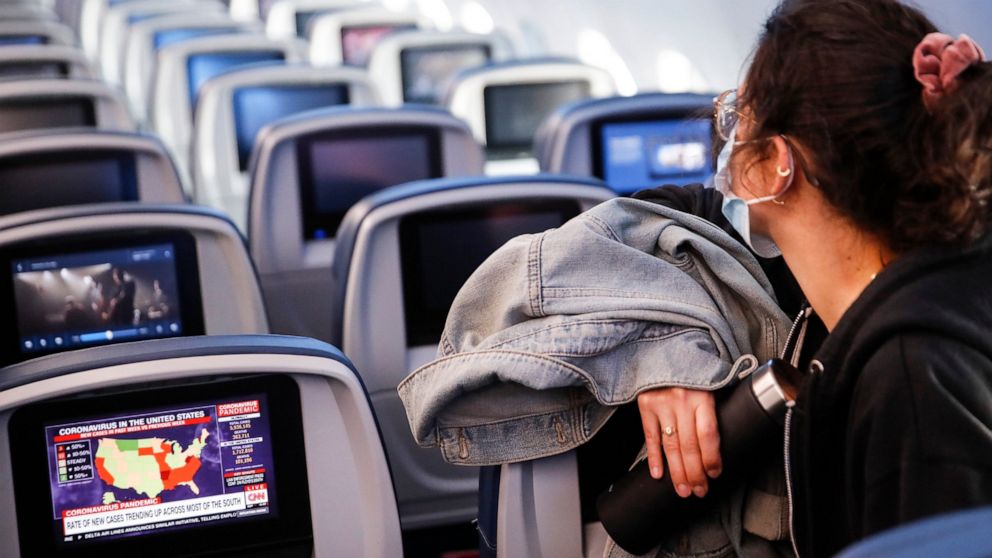“Growth has stalled” …. surge in US infections hits Delta
Delta Air Lines lost $5.7 billion during a brutal three-month stretch during with the coronavirus pandemic bringing travel to a near standstill, and any hoped-for recovery has been smothered by a resurgence of infected Americans.
“Growth has stalled,” Delta CEO Ed Bastian said. “It was growing at a pretty nice clip through June. The virus, unfortunately, was also growing.”
Bastian said it will take more than two years for the airline to make “a sustainable recovery” from the virus and the harm it is doing to the global economy.
Delta is the first U.S. airline to report financial results for the May-through-June quarter, and the numbers were ugly.
Passengers boarding Delta planes tumbled 93% from a year earlier, revenue plummeted 88%, and the company’s adjusted loss was worse than anticipated.
Airlines are expected to furlough thousands of workers when federal aid to help cover payroll expenses runs out on Oct 1. Bastian held out hope that Delta might avoid those cuts because 17,000 of its employees have accepted early retirement, and another 35,000 will be taking unpaid leave during July.
The most important financial measure in the airline business right now is cash burn, which determines how long carriers can keep flying while travel remains severely depressed. Delta has about 19 months worth of cash and short-term investments at its current burn rate of $27 million a day.
Back in March, Delta was blazing through nearly $100 million a day. Since then, it has persuaded 40,000 employees to take unpaid leave and it parked hundreds of planes to save money on fuel and maintenance.
What’s missing now are passengers willing to buy a ticket.
“Our goal is to get to break-even by the end of the year, but it’s clearly dependent on the virus starting to be contained again,” Bastian said in an interview. “There is a lot of it that is out of our control.”
Air travel within the United States fell 95% from the start of March until mid-April, when on some days fewer than 100,000 people boarded airline planes, down from more than 2 million a day a year earlier. That rose to more than 700,000 on the best days, but it has hit a plateau in July, coinciding with increased COVID-19 cases across the Sun Belt and new quarantine restrictions on visitors to states like New York, which recently reported its first day without a COVID-19 death.
Delta, along with Southwest and JetBlue, has tried to make people more comfortable about flying by limiting capacity – to about 60% on domestic flights in Delta’s case. United and American don’t block seats, and a United executive recently dismissed Delta’s approach as a public-relations ploy.
Airline customers are notoriously obsessed with jumping at the cheapest fare, even if it’s only a few dollars less. Bastian suggests that could be changing because of the pandemic – he says passengers tell the airline they are uncomfortable boarding full planes. Booking flights 100% “is not what Delta is going to do,” he said.
Delta has promised to cap seating through Sept. 30. Those limits won’t stay forever, though, because airlines can’t make money with so few seats occupied.
Delta depends on business travel for an outsized share of its revenue and profits, but Bastian acknowledged that corporate travel will be slower to recover than leisure travel as in-person meetings are replaced by Zoom calls.
Delta’s second-quarter loss compared with a year-ago profit of $1.44 billion during what is normally a strong season for airlines.
The loss included more than $2 billion in write-downs for the value of Delta’s investments in Latam Airlines, the biggest carrier in Latin America, and Aeromexico and Virgin Atlantic. All three have filed for bankruptcy or the equivalent after failing to get financial help from their governments to survive the pandemic. Delta also wrote down the value of planes that it decided to retire.
Excluding those items, Delta said its adjusted loss worked out to $3.9 billion, or $4.43 per share, wider than the $4.16 per share average in a FactSet survey of analysts.
Revenue nosedived to $1.47 billion from $12.54 billion in the same quarter last year, with domestic and international flying suffering almost equal downturns. However, total revenue was slightly better than analysts had forecast.
The average flight in the quarter was 34% full, a stunning drop from 88% a year earlier.
Even with fewer flights and fewer seats filled, Delta was able to prop up prices. Passengers paid an average of 4% more per mile than they did a year earlier.
Revenue from cargo and the SkyMiles credit card and loyalty program dropped, but not as sharply as money from tickets.
The airline raised $11 billion during the second quarter by mortgaging assets such as takeoff and landing slots, airport gates, and routes, and getting an unsecured loan from the government – part of $5.4 billion in federal aid to help pay workers through Sept. 30.
Delta has signed an agreement with the Treasury Department for an additional secured loan of $4.6 billion but hasn’t decided whether to take the money – it could find better terms on the private market.
———
David Koenig can be reached at www.twitter.com/airlinewriter
![]()


